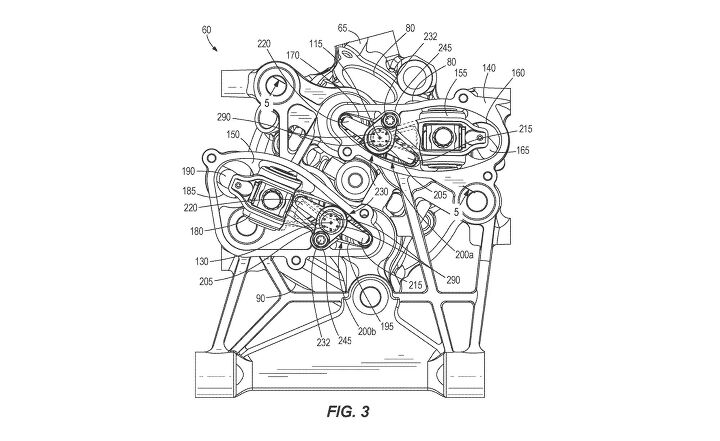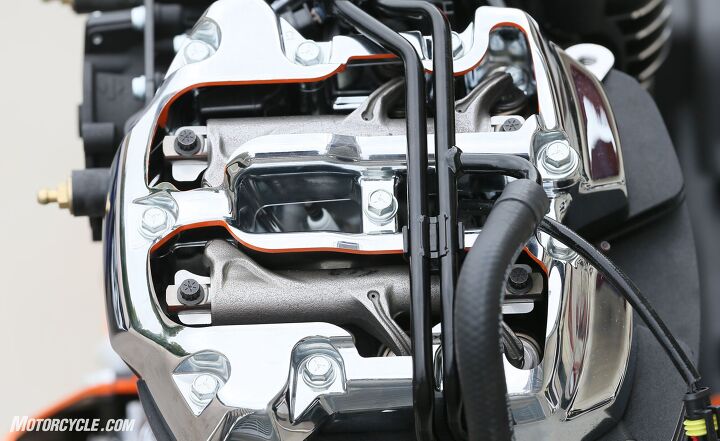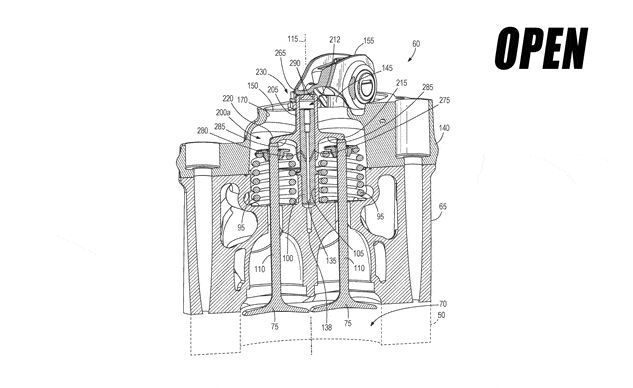It’s been a pretty busy week for Harley-Davidson, announcing its 2020 model lineup and holding its annual dealer meeting in Milwaukee. Judging from our readers’ comments, the news hasn’t been too impressive, with the highlights including the return of the Low Rider S, a new $48k CVO Tri Glide and the disappearance of a few notable models. For most of Harley’s returning lineup, the only updates are new colors and, for touring models, a new, optional suite of electronic rider aides. Those hoping for news of the Pan America or Streetfighter will be disappointed to hear Harley’s new liquid-cooled DOHC platform is still not ready for production.
While we wait for the new liquid-cooled engines, Motorcycle.com can report that development for the follow-up to Harley-Davidson’s Milwaukee-Eight engine is well underway. A new patent application filed in February, but only published this week by the U.S. Patent and Trademark Office, reveals Harley-Davidson is working on a new overhead valve system for a V-Twin engine that claims higher engine speeds than the current Milwaukee-Eight.
The most obvious visual change is the positioning of the two pushrods on either side of the cylinders instead of together on one side on Harley’s existing engines. The current engine uses the pushrods to move a pair of rocker arm shafts, one to open the two intake valves and the other opening the two exhaust valves.

The new engine design has the two pushrods each directly moving a single rocker arm, one for the two intake valves and the other for the exhaust valves.
The new engine still has four valves per cylinder, but instead of rocker arm shafts, the pushrods each open a single rocker arm. When a pushrod moves up, the rocker arm pushes down on a valve bridge that pushes the two valves down at the same time.

The valve bridge slides up and down a fixed shaft, with its two arms (#515 and #520) pushing down on the valves.
The problem with valve bridges is that they have to remain in proper alignment, otherwise the bridge arms may miss the valve stems. Harley’s patent seeks to address this problem by employing measures to prevent the valve bridges from rotating out of line. The bridge slides up and down a fixed shaft, keeping it moving in the right direction while a fastener (#230 in the diagram below) prevents it from rotating. As a result, the valves are able to continue moving in unison even as engine speeds increase.
According to patent, known bridge-type valve trains can only reach a maximum speed of 4000 rpm, but Harley-Davidson claims the new design allows for a maximum engine speed of between 6800 to 7000 rpm. The current Milwaukee-Eight, meanwhile, redlines at round 5500 rpm. The patent also claims the valve bridges will be easy to maintain, simply by lifting the rocker arms and removing the fastening screw.
Apart from the valve system, the patent does not reveal much about the rest of the engine, except to say it’s a V-Twin. The patent does include a picture of a Softail, but that appears to simply be for illustrative purposes, as it clearly shows two pushrods on the same side and does not match the rest of the drawings. Still, the drawing plus the four valves per cylinder suggest the new engine is for a potential Milwaukee-Eight replacement, though there’s nothing stopping Harley-Davidson from using the idea on a future four-valve Sportster either.
Either way, the patent tells us Harley isn’t quite ready to give up on OHV pushrod engines just yet, even as the company prepares to launch its new liquid-cooled DOHC engines.
The post Patent Filing Reveals New Harley-Davidson Pushrod Engine Design appeared first on Motorcycle.com.
【Top 10 Malaysia & Singapore Most Beautiful Girls】Have you follow?


